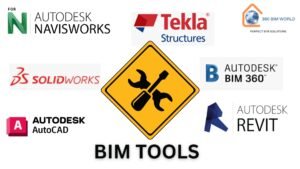Essential BIM Tools for 2024
Building Information Modeling (BIM) has revolutionized the construction industry by providing digital representations of the physical and functional aspects of buildings. In 2024, BIM remains a cornerstone of construction projects, enhancing collaboration, precision, and efficiency. This article explores ten essential BIM tools widely used in the industry today.

1. Autodesk Revit
Autodesk Revit is a premier BIM tool that supports multi-disciplinary design processes, enabling architects, engineers, and contractors to collaborate seamlessly.
Key Features:
- Parametric modeling
- Worksharing capabilities
- 3D visualization
- Detailed scheduling
Use Cases:
- Architectural design
- Structural engineering
- MEP (Mechanical, Electrical, and Plumbing) engineering
2. ArchiCAD
ArchiCAD by Graphisoft is celebrated for its intuitive interface and robust capabilities, making it a top choice among architects and designers.
Key Features:
- Comprehensive design and documentation
- Integrated rendering
- BIMx mobile access
- Collaboration tools
Use Cases:
- Residential and commercial building design
- Integrated project delivery
3. Navisworks
Navisworks by Autodesk is essential for project review, coordination, and clash detection, ensuring all project components fit together perfectly.
Key Features:
- Model aggregation
- Clash detection
- 4D and 5D simulation
- Quantification
Use Cases:
- Construction coordination
- Project scheduling
- Risk management
4. Bentley Systems
Bentley Systems offers a comprehensive suite of BIM applications, including AECOsim Building Designer and OpenBuildings Designer, tailored for complex infrastructure projects.
Key Features:
- Advanced modeling tools
- Interoperability with other software
- Detailed documentation
- Analysis and simulation
Use Cases:
- Infrastructure projects
- Rail and transit systems
- Industrial facilities
5. Tekla Structures
Tekla Structures by Trimble is a powerful tool for structural engineering, providing detailed and accurate modeling of steel and concrete structures.
Key Features:
- 3D modeling
- Fabrication-ready detailing
- Construction management
- Collaboration
Use Cases:
- Steel and concrete structures
- Industrial construction
- Precast concrete design
6. Vectorworks Architect
Vectorworks Architect offers a flexible modeling platform focused on design creativity and precision.
Key Features:
- BIM and CAD capabilities
- Landscape design tools
- Integrated rendering
- Site modeling
Use Cases:
- Architectural design
- Landscape architecture
- Urban planning
7. Solibri
Solibri is a quality assurance tool that ensures BIM model integrity and compliance with building regulations and standards.
Key Features:
- Model checking
- Clash detection
- Code compliance
- Quantity takeoff
Use Cases:
- Quality control
- Regulatory compliance
- Risk mitigation
8. BIM 360
BIM 360 by Autodesk is a cloud-based platform for project delivery and construction management, enhancing collaboration and data sharing.
Key Features:
- Document management
- Field management
- Project collaboration
- Construction coordination
Use Cases:
- Project management
- Field collaboration
- Construction site management
9. Bluebeam Revu
Bluebeam Revu is a PDF-based collaboration tool that integrates with BIM workflows, allowing efficient markup and team collaboration.
Key Features:
- PDF creation and markup
- Document management
- Real-time collaboration
- Integration with BIM models
Use Cases:
- Document review
- Team collaboration
- Project communication
10. SolidWorks
SolidWorks by Dassault Systèmes is known for its robust CAD capabilities and integration with BIM workflows to enhance design precision and collaboration.
Key Features:
- 3D CAD modeling
- Simulation and analysis
- Detailed documentation
- Integration with BIM environments
Use Cases:
- Mechanical design
- Industrial equipment
- Building components
FAQ: Tools Used in BIM
What is BIM software used for?
BIM software creates and manages digital representations of physical and functional characteristics of buildings and infrastructure, facilitating design, documentation, construction, and facility management.
Why is Autodesk Revit so popular?
Autodesk Revit is popular due to its multi-disciplinary design collaboration, robust parametric modeling, and seamless integration with other Autodesk products, making it a comprehensive tool for the AEC industry.
Can BIM tools be used for infrastructure projects?
Yes, BIM tools like Bentley Systems’ applications and Autodesk’s suite are widely used for infrastructure projects, including roads, bridges, railways, and utilities.
What is the difference between CAD and BIM?
CAD (Computer-Aided Design) focuses on creating detailed 2D and 3D drawings, while BIM (Building Information Modeling) encompasses creating a comprehensive digital model that includes both geometric representation and functional and physical properties of a building.
How does clash detection work in BIM?
Clash detection in BIM involves analyzing 3D models to identify and resolve conflicts between different building components, such as structural elements and MEP systems. Tools like Navisworks are used for this purpose.
Is BIM only for large projects?
No, BIM can be used for projects of any size. While particularly beneficial for large, complex projects, the advantages of improved collaboration, accuracy, and efficiency also apply to smaller projects.
What are the benefits of cloud-based BIM platforms like BIM 360?
Cloud-based BIM platforms offer benefits such as real-time collaboration, centralized data storage, improved accessibility from anywhere, and enhanced project management capabilities.
How do BIM tools contribute to sustainability?
BIM tools contribute to sustainability by enabling precise energy analysis, material optimization, and lifecycle assessment, helping to design and construct more efficient and environmentally friendly buildings.
Can BIM tools integrate with other software?
Yes, many BIM tools offer interoperability with other software, allowing seamless data exchange and collaboration across different platforms and disciplines.
How do I choose the right BIM tool for my project?
Choosing the right BIM tool depends on your specific project needs, budget, and project scale. It’s essential to consider the tool’s features, ease of use, and compatibility with other software in your workflow.
Conclusion
BIM tools are indispensable in modern construction and design processes. They enhance collaboration, improve accuracy, and streamline project management, making them crucial for the AEC industry in 2024. Whether working on a small residential project or a large infrastructure development, a BIM tool can meet your needs.


Pingback: BIM MEP Coordination: Fundamental Rules for Success in the AEC Industry - 360 BIM WORLD